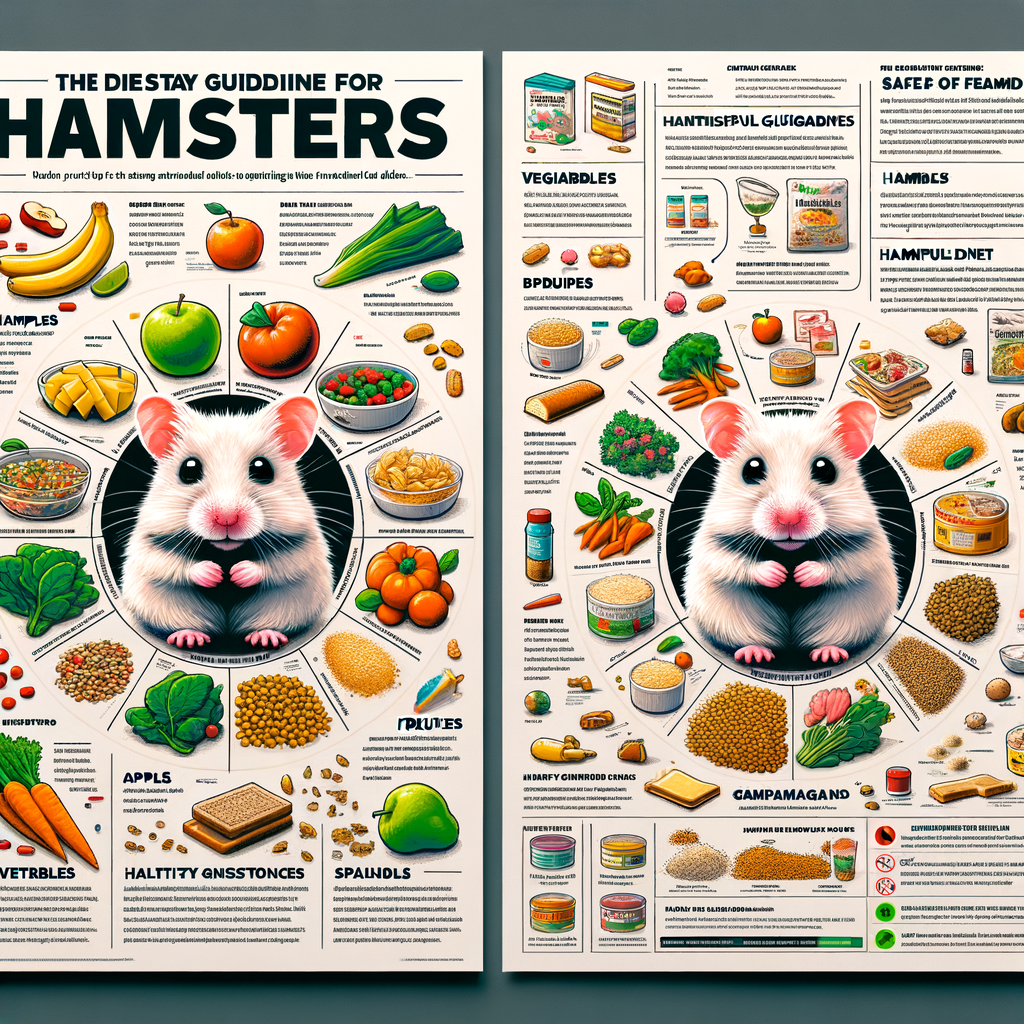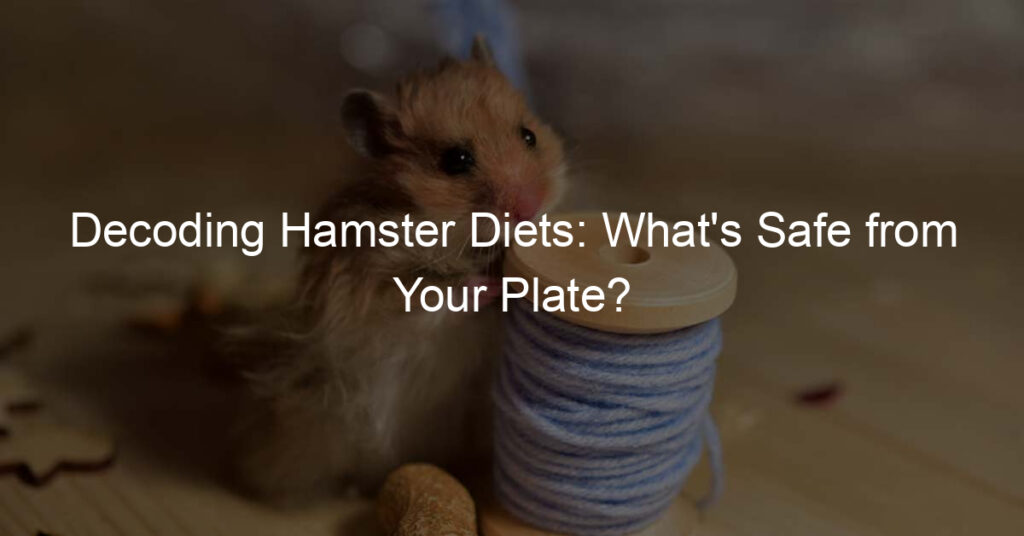
Introduction to Hamster Diets
When it comes to hamster care, a proper diet plays a pivotal role. Just like humans, hamsters need a balanced diet to stay healthy and live a long life. This introduction will help you understand the importance of a balanced diet for hamsters and dispel some common misconceptions about hamster nutrition.
- Understanding the importance of a balanced diet for hamsters
- Common misconceptions about hamster nutrition
Hamsters are small creatures, but their dietary requirements are quite complex. They need a mix of fruits, vegetables, grains, and proteins to meet their nutritional needs. A balanced diet for a hamster should include a variety of foods to ensure they get all the necessary nutrients. This not only keeps them healthy but also contributes to their overall happiness and well-being.
There are many misconceptions about what hamsters should eat. One common myth is that hamsters can survive on seeds alone. While seeds are a part of their diet, they should not be the only food source. Hamsters also need fruits, vegetables, and proteins to maintain a balanced diet. Another misconception is that all fruits and vegetables are safe for hamsters. However, some foods, like onions and garlic, can be harmful to them. It’s essential to research and consult with a vet before introducing new foods into your hamster’s diet.
In the following sections, we will delve deeper into hamster feeding, safe and dangerous foods for hamsters, and provide a closer look at hamster nutrition. We will also share some useful hamster food tips to help you ensure your furry friend is getting the best nutrition possible.
Understanding Hamster Feeding
Feeding your hamster properly is an essential part of pet ownership. It’s not just about giving them food, but about providing the right kind of food in the correct amounts. Let’s delve into the guidelines for a healthy hamster diet.
Hamster Diet Guidelines
When it comes to feeding your hamster, there are two main areas you need to focus on: the essential nutrients they need and the recommended portion sizes.
- Essential Nutrients for Hamsters
Hamsters, like all animals, require certain nutrients to stay healthy. These include:
- Proteins: Hamsters need protein for growth and repair. Good sources include hamster-safe vegetables, fruits, and commercial hamster food.
- Fats: Fats provide energy and help absorb vitamins. Seeds and nuts are good sources, but should be given in moderation due to their high fat content.
- Carbohydrates: Carbs also provide energy. They can be found in grains and vegetables.
- Vitamins and Minerals: These are vital for a hamster’s overall health. They can be found in a variety of foods, including vegetables, fruits, and commercial hamster food.
- Recommended Portion Sizes
Portion control is crucial when feeding your hamster. Overfeeding can lead to obesity and other health problems. Here are some general guidelines:
- Commercial Hamster Food: A tablespoon per day is typically sufficient for most hamsters.
- Fruits and Vegetables: These should make up a smaller portion of your hamster’s diet. A small piece of fruit or vegetable every other day is enough.
- Treats: Treats should be given sparingly, no more than once or twice a week.
Remember, these are general guidelines. Each hamster is unique, so you may need to adjust portion sizes based on your hamster’s size, age, and activity level.
Safe Foods for Hamsters
Feeding your hamster a balanced diet is essential for their health and happiness. While commercial hamster food provides a good base, supplementing it with safe people food can add variety and additional nutrients. Here, we will discuss some safe people foods that can be included in your hamster’s diet.
People Food for Hamsters
Hamsters are omnivores, which means they can eat both plant-based and animal-based foods. However, not all human foods are safe for hamsters. Let’s explore some safe options.
- Vegetables and fruits that are safe for hamsters:
- Grains and seeds that can be included in a hamster’s diet:
Hamsters can enjoy a variety of fruits and vegetables, but they should be given in moderation to avoid digestive issues. Safe options include apples (without seeds), bananas, blueberries, cucumbers, carrots, and peas. Always wash fruits and vegetables thoroughly to remove any pesticides and cut them into small, manageable pieces.
Grains and seeds are a great source of energy for hamsters. You can include oats, barley, wheat, and millet in your hamster’s diet. Seeds like pumpkin seeds, sunflower seeds, and sesame seeds are also safe for hamsters. However, seeds should be given sparingly as they can be high in fat.
Remember, while these people foods are safe for hamsters, they should only make up a small part of their diet. The majority of their diet should be a high-quality commercial hamster food. Always introduce new foods slowly and watch for any signs of digestive upset.
Dangerous Foods for Hamsters
While hamsters are known for their love of food, not all foods are safe for them to consume. In fact, some can be downright dangerous. It’s essential to understand what foods to avoid in a hamster’s diet to ensure their health and longevity.
Foods to Avoid in Hamster Diets
Here are some common foods that should never be included in a hamster’s diet:
- Common household foods that are toxic to hamsters
- The dangers of overfeeding certain foods
Several common household foods can be toxic to hamsters. These include chocolate, caffeine, alcohol, onions, garlic, raw potatoes, and most citrus fruits. These foods can cause digestive issues, and in severe cases, can even lead to death. It’s important to always check if a food is safe before offering it to your hamster.
Even foods that are safe for hamsters can become dangerous if overfed. For example, fruits and vegetables are good for hamsters in moderation, but too much can cause diarrhea and other digestive issues. Similarly, too many fatty or sugary foods can lead to obesity and related health problems. Always monitor your hamster’s food intake and adjust as necessary to maintain a healthy weight.
Remember, a well-balanced diet is key to a healthy, happy hamster. Always do your research and consult with a vet if you’re unsure about a particular food.
| Food | Safe for Hamsters? |
|---|---|
| Chocolate | No |
| Caffeine | No |
| Alcohol | No |
| Onions | No |
| Garlic | No |
| Raw Potatoes | No |
| Citrus Fruits | No |
| Fruits (in moderation) | Yes |
| Vegetables (in moderation) | Yes |
Hamster Nutrition: A Closer Look
Understanding the nutritional needs of your hamster is crucial for its health and longevity. A well-balanced diet can ensure your furry friend remains active, happy, and healthy. Let’s delve deeper into the world of hamster nutrition and explore what foods are beneficial for them.
What Can Hamsters Eat?
Hamsters are omnivores, which means they can eat a variety of foods, including fruits, vegetables, seeds, nuts, and even small amounts of meat. However, not all foods are safe for hamsters, and some can even be harmful. Let’s take a closer look at the impact of different diets on hamster health and the key takeaways for maintaining a healthy diet for your hamster.
- Case study: The effects of different diets on hamster health
- Key takeaways for maintaining a healthy hamster diet
- Provide a variety of foods to ensure a balanced diet.
- Avoid foods high in sugar and fat.
- Always provide fresh water.
- Monitor your hamster’s weight and adjust its diet accordingly.
A study conducted on two groups of hamsters, one fed with a balanced diet and the other with a diet high in fats and sugars, showed significant differences in their health. The hamsters on the balanced diet were more active, had shinier coats, and lived longer than those on the high-fat, high-sugar diet. This study clearly shows the importance of a balanced diet for hamsters.
Here are some key points to remember when feeding your hamster:
In conclusion, a balanced diet is essential for your hamster’s health. By understanding what foods are beneficial and which ones to avoid, you can ensure your hamster lives a long, healthy life.
Hamster Food Tips
Feeding your hamster a balanced diet is crucial for their health and happiness. Here are some tips to help you provide the best nutrition for your furry friend.
Making Your Own Hamster Food
Creating homemade hamster food can be a fun and rewarding process. Not only does it allow you to control the ingredients, but it also provides an opportunity to cater to your hamster’s specific dietary needs. Let’s explore some recipes and tips for homemade hamster food.
- Recipes for Homemade Hamster Food
- 1/4 cup of barley
- 1/4 cup of millet
- 1/4 cup of shelled sunflower seeds
- 1/4 cup of chopped carrots
- 1/4 cup of chopped broccoli
- Tips for Storing and Serving Hamster Food
- Storage: Store dry hamster food in a cool, dry place. Use airtight containers to keep the food fresh and prevent pests.
- Serving: Serve fresh food in small amounts to prevent waste. Remove any uneaten fresh food after 24 hours to avoid spoilage.
One simple recipe involves a mix of grains, seeds, and vegetables. Here’s a quick guide:
Mix all the ingredients together and serve in your hamster’s food dish. Remember, fresh food should be removed after 24 hours to prevent spoilage.
Proper storage and serving of hamster food can help maintain its freshness and nutritional value. Here are some tips:
Remember, while homemade food can be a great addition to your hamster’s diet, it should not replace a balanced commercial hamster food. Always consult with a vet to ensure your hamster’s dietary needs are being met.
Conclusion: The Importance of a Healthy Hamster Diet
In this article, we have discussed the importance of a healthy diet for hamsters. It is crucial to understand that the food we provide our furry friends can significantly impact their lifespan and quality of life. Let’s recap what we’ve learned.
- Recap of safe and dangerous foods for hamsters:
- The role of diet in a hamster’s lifespan and quality of life:
Safe foods for hamsters include fruits like apples and bananas, vegetables like carrots and broccoli, and grains like brown rice and oats. Always remember to serve these in small, manageable portions. On the other hand, foods like onions, garlic, and chocolate are dangerous for hamsters and should be avoided at all costs.
A balanced diet is key to a hamster’s health and longevity. Hamsters fed with a proper diet have been observed to live longer and exhibit more energy and vitality. They are less likely to suffer from common health issues like obesity, diabetes, and heart disease. In contrast, a poor diet can lead to various health problems and a shortened lifespan.
Remember, every hamster is unique and may have specific dietary needs. Always consult with a vet or a pet nutrition expert to ensure your hamster’s diet is balanced and suitable for its specific needs.
By providing our hamsters with the right foods and avoiding the dangerous ones, we can ensure they live a long, healthy, and happy life. The importance of a healthy diet for our hamsters cannot be overstated. After all, a healthy hamster is a happy hamster!








